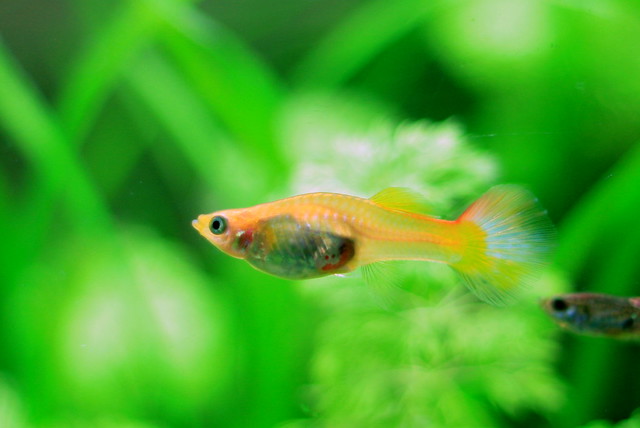Equipment Needed:
- Breeder Box or Breeder Net
- Breeding Grass
- 5 or 10 gallon tank for the baby fish or a tank divider that you can use for your main tank.
- A pair - 1 female and 1 male
 |
| Guppy - Photo by tartaruga33 |
Place the male and female in the same tank together and they will soon mate. You are probably asking, how can I tell when the female is pregnant? When a female guppy is pregnant she will develop a dark triangular shaped gravid spot near her anal vent. This will get larger and darker as the pregnancy progresses. While you are waiting on the female to develop the fry it's time to make sure you are prepared for the delivery. We use plastic breeder boxes and always have without any problems. A breeder box is a small box plastic box about 4 inches long by 3 inches wide and 4 inches deep. There is a removable "V" shaped trap in it which serves to separate the mother from the babies. When the mother fish has babies they fall through the slot in the "V" into the bottom of the box.
After the mother is finished having babies, you can remove the "V" trap so that the babies have more room to grow. Some people have had bad experiences with breeder boxes and now only use a breeding net. It is also a good idea to purchase some real or plastic breeding grass for the top of the aquarium. The breeding grass is just in case the mother gives birth before you have a chance to put her in the breeder box. The young babies instinctively will swim to the top of the aquarium and the breeder grass provides a great hiding place so they won't get eaten by the bigger fish in your tank.
To feed your new arrivals you can use finely crushed flake food. Using your fingers, you can rub the flakes into a fine powder. Some only feed live foods such as baby brine shrimp. Live foods would definitely be the best way to go, but for most this is simply not feasible. Crushed or powdered flake food will suffice. Try to feed the babies 3 very small meals per day. You will invariably feed too much and the excess food will drop to the bottom of the tank or breeder box. To clean a breeder box we like to take a 3 ft. length of aquarium tubing and a small bucket. Use the tubing as a siphon to clean the bottom of the breeder box. Be careful not to siphon any baby fish.
Try to perform 25% water changes weekly for your baby guppies. This will aid in the optimal growth of your baby tropical fish. After a few weeks in the breeder box your new babies will soon outgrow their home and you will need to move them either to a new tank or your main tank with a divider installed. By 8 weeks old your baby fish will most likely be able to return to the main tank without a divider. However, it really depends on the size of the other inhabitants in your aquarium. Use your best judgement before releasing them into the main tank.
 |
| Swordtails - Photo by Eric F Savage |
Whether you are going for that one of kind strain or if you simply find small fry swimming in the top of your tank one day after work, please be responsible with your fish. If you have more than you can accomodate you can try trading them or maybe even selling them to a local fish store in your area.
Talk to your local pet stores beforehand to see if you can work out some sort of arrangement. You can also use this opportunity to get your friends interested in fish.

